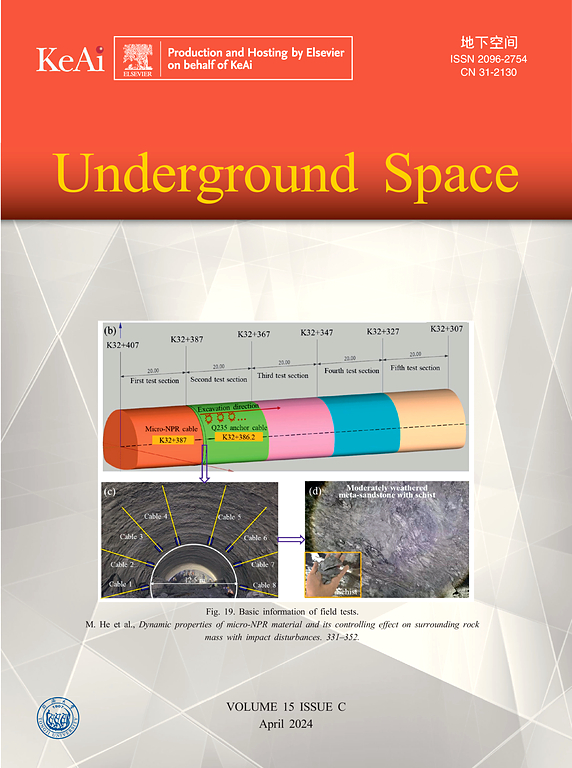Passive instability of longitudinally inclined shallowly-buried shield tunnel using physical model tests and DEM simulations
IF 8.3
1区 工程技术
Q1 ENGINEERING, CIVIL
引用次数: 0
Abstract
Stability of tunnel face is crucial, but previous studies often overlooked the effect of longitudinal tunnel inclination, leading to inaccurate stability assessments. In this study, nine groups of 1g model tests were conducted to study the influence of longitudinal tunnel inclination on passive limit support pressure and passive failure mode of soil in front of the tunnel face under shallow burial conditions (i.e., cover depth ratio of 0.25, 0.50 and 0.75) in a sand stratum. In addition, discrete element method (DEM) analyses at the same scale were established and calibrated against the model test results. Accordingly, the micromechanical information of soil was derived from a microscopic perspective. The results indicate that upon the passive instability of tunnel face, the soil in front of the tunnel face firstly moved approximately perpendicular to the tunnel face, and then it deflected. The instability area of soil in front of the tunnel face increased with the decrease of longitudinal inclination, when the tunnel cover depth was fixed. Furthermore, microscopic analyses indicate that the longitudinal inclination could significantly affect the soil contact orientation in front of the tunnel face. This was more likely to cause the failure zone to rotate.
纵向倾斜浅埋盾构隧道被动失稳物理模型试验与DEM模拟
隧道工作面稳定性至关重要,但以往的研究往往忽略了隧道纵向倾斜的影响,导致稳定性评估不准确。本研究通过9组1g模型试验,研究浅埋条件下(覆盖深度比分别为0.25、0.50和0.75)沙层中隧道纵向倾斜对隧道前方土体被动极限支撑压力和被动破坏模式的影响。此外,建立了相同尺度下的离散元法(DEM)分析,并根据模型试验结果进行了校正。因此,从微观角度获得了土壤的微观力学信息。结果表明:在隧道工作面被动失稳时,隧道工作面前方土体先近似垂直于工作面移动,然后发生偏转;当隧道覆盖深度一定时,巷道前方土体失稳面积随着纵向倾斜度的减小而增大。细观分析表明,纵向倾角对巷道前方土体接触方向有显著影响。这更有可能导致故障区旋转。
本文章由计算机程序翻译,如有差异,请以英文原文为准。
求助全文
约1分钟内获得全文
求助全文
来源期刊

Underground Space
ENGINEERING, CIVIL-
CiteScore
10.20
自引率
14.10%
发文量
71
审稿时长
63 days
期刊介绍:
Underground Space is an open access international journal without article processing charges (APC) committed to serving as a scientific forum for researchers and practitioners in the field of underground engineering. The journal welcomes manuscripts that deal with original theories, methods, technologies, and important applications throughout the life-cycle of underground projects, including planning, design, operation and maintenance, disaster prevention, and demolition. The journal is particularly interested in manuscripts related to the latest development of smart underground engineering from the perspectives of resilience, resources saving, environmental friendliness, humanity, and artificial intelligence. The manuscripts are expected to have significant innovation and potential impact in the field of underground engineering, and should have clear association with or application in underground projects.
 求助内容:
求助内容: 应助结果提醒方式:
应助结果提醒方式:


